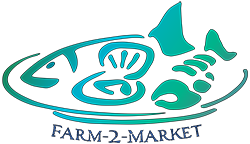
Everything You Need to Know About Blue Point Oysters
Blue Point oysters have been a popular choice for oyster lovers since the 1800s. With their distinctly briny flavor and rich history, it's no wonder why many oyster producers are guilty of illegitimately adapting their name.
The oyster connoisseurs at Farm-2-Market have created a guide to everything you need to know about the highly-regarded Blue Point oysters.
Blue Pont Oysters – What You Need to Know
- Location is everything
Although Blue Point oysters get their name from a small village in Long Island, NY, they must spend a minimum of three months during their 3-4-year growth period in Great South Bay to fit the criteria of Blue Points. Unfortunately, many oyster growers from neighboring regions disregard this strict definition, and label their own oysters as Blue Points, despite their location. Conversely, producers may give their oysters a different name even if they fit the criteria to be called "Blue Points". This is allowed if the oysters are moved to various locations over the years. Although Blue Point oysters are well known, highly regarded oysters; some producers may choose to assign a different name to raise the price of their product.
- Widely consumed throughout history
In the 19th century, oysters were much more widely consumed. Commonly prepared in the homes of Americans, as well as in your average bar or restaurant, Blue Point oysters became a widely recognized choice due to consistent supply and excellent flavor. As oyster consumption has decreased over the years, Blue Point oysters have managed to maintain their status as a popular choice for oysters.
- A unique taste
Blue Point oysters stem from a small seed and grow on the bottom of the sea. They reach a size of approximately 3-4 inches and are known to have a briny, mildly salty and sweet taste, most often served raw with minimal toppings. Blue Point oysters are normally transferred from shallow to deep waters periodically during their growing period, in order to achieve a consistent size and flavor.
These oysters face the most adverse weather conditions in the summer months due to their position in Great South Bay. For this reason, it is best to buy these oysters between September and April. Blue points that are purchased during the summer are likely to have been harvested earlier in the year and will not be as fresh.
Farm-2-Market Has Top Oyster Options
If you are looking into buying fresh Blue Point oysters or other seafood, look no further than Farm-2-Market. For more information on our high-quality seafood products, call us today and speak to one of our experts at 800-477-2967.
